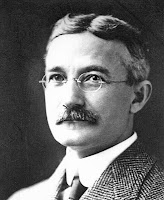 |
| Mayor Pierce. City of Boise. |
With little education beyond “a course in a business college,” Walter found what work he could in Missouri and Kansas: sheep herder, hotel operator, railroad contractor, and, finally, real estate developer. Perseverance and natural talent eventually brought him notable success. However, falling farm prices and other outside factors crippled the Kansas economy in the late 1880s, so Pierce began to look elsewhere.
In Morton County, Kansas, Pierce had met John M. Haines and Lindley H. Cox. The three established the firm of W. E. Pierce & Company and moved to Boise City in 1890, shortly after Idaho became a state. Pierce and the firm would be a driving force in the city’s development for over half a century.
Walter quickly hit his stride as a real estate and business developer. He played a role in the Boise Rapid Transit Company, which built the city’s first electric trolley line in 1891. He soon rose to prominence in the city and was elected Mayor of Boise in 1895. Despite considerable nay-saying, he initiated the first street-paving program as well as other civic improvements that were later lauded as “the right thing to do.”
The Illustrated History, published in 1899, said “He was the most progressive mayor that Boise ever had, and under his management an immense stride was taken toward a more brilliant future.”
 |
| Idaho Building, ca 1918. J. H. Hawley. |
In 1910, Pierce spearheaded construction of what many would later call Boise’s first skyscraper, the Idaho Building. The Idaho Statesman observed that the six-story structure, tall for its day, “towers above its neighbors like a mountain peak.”
Pierce and his company also expanded the interurban railway system to encompass most of the Boise Valley. They knew well that rail service added significant value to their real estate holdings and allowed them to turn properties over much more quickly. (The interurban system was dismantled in 1928, after automobiles became more common.)
Pierce also became interested in some mining properties along the Gold Fork River, about sixteen miles south of McCall. He and two associates incorporated the Gold Fork Mining Company (Idaho Statesman, January 19, 1916) and planned to dredge in the area. However, the advent of World War I caused manpower shortages and increased costs, so little seems to have come from that investment.
Still, Pierce’s primary developments continued to be home and building construction. The Hotel Boise, completed in 1930, was among the most important. It’s Historic Place nomination noted that the “reinforced concrete, eleven-story edifice was the tallest commercial structure in Boise for a generation.”
In 1947, Pierce sold a home he had built in 1914 to the state of Idaho for use as a Governor’s Mansion. Four years later, Pierce passed away and was buried in Boise’s Morris Hill Cemetery. The fine house served as the Governor’s home for over forty years until it no longer met the state’s needs and was sold at auction.
| References: [French], [Hawley], [Illust-State] |
| Arthur Hart, “Idaho history: 1910 was a big building year for Boise,” Idaho Statesman (April 11, 2010). |
| Kyle True, “Walter E. Pierce House,” Boise Architecture Project, online (2009). |

Thank you, he was my great grandfather. My daughter's middle name is Pierce in honor of the family name.
ReplyDelete